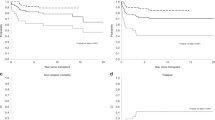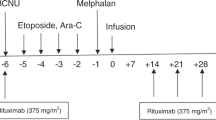Abstract
High-dose therapy (HDT) with autologous stem cell transplantation (ASCT) is the optimal treatment for patients with relapsed aggressive non-Hodgkin's lymphoma (NHL). HDT, however, is often reserved for relatively younger patients due to limited data in older adults. We treated 53 patients aged 60 years and older (median age 62 years, range 60.3–67.7 years) with HDT and ASCT for NHL at our centers. Forty-four patients (83%) had aggressive histology, 75% had chemosensitive disease and all had failed anthracycline therapy. Conditioning regimens included busulfan, melphalan, and thiotepa (45%); cyclophosphamide (CY), etoposide (VP-16), and total body irradiation (TBI) (30%); CY and TBI (15%); and other regimens (10%). Estimated 4-year overall survival (OS), progression-free survival, and treatment-related mortality (TRM) were 33%, 24% and 22%, respectively. A multivariable analysis demonstrated that patients with chemosensitive disease (P = 0.03) and ⩽3 prior regimens (P = 0.03) had superior survival. Four-year OS in patients with chemosensitive disease was 39% vs15% in patients with chemoresistant disease. Reduced TRM was associated with the CY, VP-16 and TBI regimen (P = 0.02). HDT therapy with ASCT may result in prolonged survival and potential cure for about a quarter of elderly patients, and for almost 40% with chemosensitive disease. Optimal conditioning regimen selection may further improve outcome by reducing TRM. Age alone should not be used to exclude patients from receiving myeloablative therapy with ASCT. Bone Marrow Transplantation (2001) 27, 593–599.
This is a preview of subscription content, access via your institution
Access options
Subscribe to this journal
Receive 12 print issues and online access
$259.00 per year
only $21.58 per issue
Buy this article
- Purchase on Springer Link
- Instant access to full article PDF
Prices may be subject to local taxes which are calculated during checkout





Similar content being viewed by others
References
O'Reilly SE, Connors JM, Macpherson N et al. Lymphomas in the elderly Clin Geriatr Med 1997 13: 251–263
Devesa SS, Fears T . Non-Hodgkin's lymphoma time trends: United States and international data Cancer Res 1992 52: 5432s–5440s
Cohen H . Cancer and aging ASCO Educational Book American Society of Clinical Oncology: Alexandria, VA 1998 pp 223–226
Vital and Health Statistics: Trends in the Health of Older Americans, 1994: Centers for Disease Control and Prevention/National Center for Health Statistics, 1994. US Department of Health and Human Services, April 1995. Report No: Series 3, No. 30
Tirelli U, Errante D, Van Glabbeke M et al. CHOP is the standard regimen in patients > or = 70 years of age with intermediate-grade and high-grade non-Hodgkin's lymphoma: results of a randomized study of the European Organization for Research and Treatment of Cancer Lymphoma Cooperative Study Group J Clin Oncol 1998 16: 27–34
Philip T, Guglielmi C, Hagenbeek A et al. Autologous bone marrow transplantation as compared with salvage chemotherapy in relapses of chemotherapy-sensitive non-Hodgkin's lymphoma New Engl J Med 1995 333: 1540–1545
Press O, Fisher R, Dalla-Favera R . Aggressive non-Hodgkin's lymphomas Educational Program of the American Society of Hematology 1996 pp 48–61
Petersen FB, Buckner CD, Appelbaum FR et al. Etoposide, cyclophosphamide and fractionated total body irradiation as a preparative regimen for marrow transplantation in patients with advanced hematological malignancies: a phase I study Bone Marrow Transplant 1992 10: 83–88
Petersen FB, Appelbaum FR, Hill R et al. Autologous marrow transplantation for malignant lymphoma: a report of 101 cases from Seattle J Clin Oncol 1990 8: 638–647
Gulati S, Yahalom J, Acaba L et al. Treatment of patients with relapsed and resistant non-Hodgkin's lymphoma using total body irradiation, etoposide, and cyclophosphamide and autologous bone marrow transplantation J Clin Oncol 1992 10: 936–941
Weaver CH, Appelbaum FR, Petersen FB et al. High-dose cyclophosphamide, carmustine, and etoposide followed by autologous bone marrow transplantation in patients with lymphoid malignancies who have received dose-limiting radiation therapy J Clin Oncol 1993 11: 1329–1335
Kusnierz-Glaz CR, Schlegel PG, Wong RM et al. Influence of age on the outcome of 500 autologous bone marrow transplant procedures for hematologic malignancies J Clin Oncol 1997 15: 18–25
Miller CB, Piantadosi S, Vogelsang GB et al. Impact of age on outcome of patients with cancer undergoing autologous bone marrow transplant J Clin Oncol 1996 14: 1327–1332
Sweetenham JW, Pearce R, Philip T et al. High-dose therapy and autologous bone marrow transplantation for intermediate and high grade non-Hodgkin's lymphoma in patients aged 55 years and over: results from the European Group for Bone Marrow Transplantation. The EBMT Lymphoma Working Party Bone Marrow Transplant 1994 14: 981–987
Stamatoullas A, Fruchart C, Khalfallah S et al. Peripheral blood stem cell transplantation for relapsed or refractory aggressive lymphoma in patients over 60 years of age Bone Marrow Transplant 1997 19: 31–35
Harris NL, Jaffe ES, Stein H et al. A revised European–American classification of lymphoid neoplasms: a proposal from the International Lymphoma Study Group Blood 1994 84: 1361–1392
Gooley TA, Leisenring W, Crowley J, Storer BE . Estimation of failure probabilities in the presence of competing risks: new representations of old estimators Stat Med 1999 18: 695–706
Gomez H, Hidalgo M, Casanova L et al. Risk factors for treatment-related death in elderly patients with aggressive non-Hodgkin's lymphoma: results of a multivariate analysis J Clin Oncol 1998 16: 2065–2069
Krishnan A, Bhatia S, Slovak ML et al. Predictors of therapy-related leukemia and myelodysplasia following autologous transplantation for lymphoma: an assessment of risk factors Blood 2000 95: 1588–1593
Freedman AS, Neuberg D, Mauch P et al. Long-term follow-up of autologous bone marrow transplantation in patients with relapsed follicular lymphoma Blood 1999 94: 3325–3333
Stiff PJ, Dahlberg S, Forman SJ et al. Autologous bone marrow transplantation for patients with relapsed or refractory diffuse aggressive non-Hodgkin's lymphoma: value of augmented preparative regimens – a Southwest Oncology Group trial J Clin Oncol 1998 16: 48–55
Bierman PJ, Vose JM, Anderson JR et al. High-dose therapy with autologous hematopoietic rescue for follicular low-grade non-Hodgkin's lymphoma J Clin Oncol 1997 15: 445–450
Rodriguez MA, Cabanillas FC, Velasquez W et al. Results of a salvage treatment program for relapsing lymphoma: MINE consolidated with ESHAP J Clin Oncol 1995 13: 1734–1741
Wilson WH, Bryant G, Bates S et al. EPOCH chemotherapy: toxicity and efficacy in relapsed and refractory non-Hodgkin's lymphoma J Clin Oncol 1993 11: 1573–1582
Chao NJ, Rosenberg SA, Horning SJ . CEPP(B): an effective and well-tolerated regimen in poor-risk, aggressive non-Hodgkin's lymphoma Blood 1990 76: 1293–1298
Freedman AS, Gribben JG, Nadler LM . High dose therapy and autologous stem cell transplantation in follicular non-Hodgkin's lymphoma Leuk Lymphoma 1998 28: 219–230
Balducci L, Lyman GH . Cancer in the elderly. Epidemiologic and clinical implications Clin Geriatr Med 1997 13: 1–14
Byrne A, Carney DN . Cancer in the elderly Curr Probl Cancer 1993 17: 145–218
Baker SD, Grochow LB . Pharmacology of cancer chemotherapy in the older person Clin Geriatr Med 1997 13: 169–183
Bearman SI, Appelbaum FR, Back A et al. Regimen-related toxicity and early posttransplant survival in patients undergoing marrow transplantation for lymphoma J Clin Oncol 1989 7: 1288–1294
Acknowledgements
This work was supported by grants P01CA44991, K23CA85479, American Society of Clinical Oncology Young Investigator Award.
Author information
Authors and Affiliations
Rights and permissions
About this article
Cite this article
Gopal, A., Gooley, T., Golden, J. et al. Efficacy of high-dose therapy and autologous hematopoietic stem cell transplantation for non-Hodgkin's lymphoma in adults 60 years of age and older. Bone Marrow Transplant 27, 593–599 (2001). https://doi.org/10.1038/sj.bmt.1702833
Received:
Accepted:
Published:
Issue Date:
DOI: https://doi.org/10.1038/sj.bmt.1702833
Keywords
This article is cited by
-
The Karolinska experience of autologous stem-cell transplantation for lymphoma: a population-based study of all 433 patients 1994–2016
Experimental Hematology & Oncology (2019)
-
Toxicity and efficacy of autologous hematopoietic cell transplantation in elderly patients with aggressive lymphoma: a historical prospective study
Annals of Hematology (2018)
-
Carmustine replacement in intensive chemotherapy preceding reinjection of autologous HSCs in Hodgkin and non-Hodgkin lymphoma: a review
Bone Marrow Transplantation (2017)
-
High-Dose Chemotherapy and Autologous Stem Cell Transplant in Older Patients with Lymphoma
Current Oncology Reports (2015)
-
Biodistribution, radiation dosimetry and scouting of 90Y-ibritumomab tiuxetan therapy in patients with relapsed B-cell non-Hodgkin’s lymphoma using 89Zr-ibritumomab tiuxetan and PET
European Journal of Nuclear Medicine and Molecular Imaging (2012)



